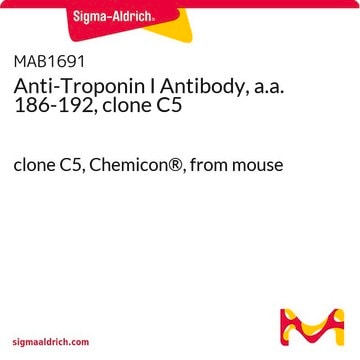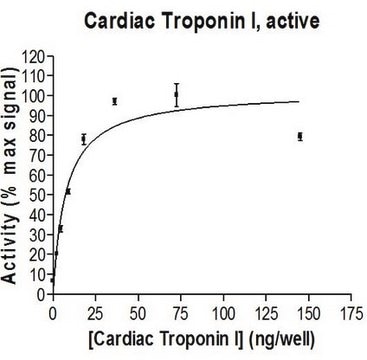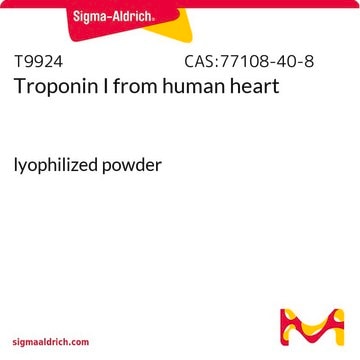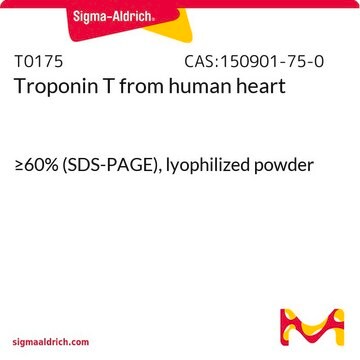MAB3152
Anti-Cardiac Troponin I Antibody, a.a. 87-91, clone 8E10
clone 8E10, Chemicon®, from mouse
Synonym(s):
cTn1, Cardiac Troponin I
Sign Into View Organizational & Contract Pricing
All Photos(1)
About This Item
UNSPSC Code:
12352203
eCl@ss:
32160702
NACRES:
NA.41
Recommended Products
biological source
mouse
Quality Level
antibody form
purified antibody
clone
8E10, monoclonal
species reactivity
canine, rabbit, feline, human, bovine, pig, goat
should not react with
rat, mouse, fish
manufacturer/tradename
Chemicon®
technique(s)
ELISA: suitable
western blot: suitable
isotype
IgG1
NCBI accession no.
UniProt accession no.
shipped in
wet ice
target post-translational modification
unmodified
Specificity
MAB3152 reacts equally with free cardiac troponin 1 (cTn1) and cTn1 forming complexes with other troponin components. It recognizes epitopes that are not perturbed or sterically shielded by other troponin components. Not affected by heparin, phosphorylation, oxidation and complex formation. Recognizes an epitope located between amino acid residues 87 and 91 of cTnI. There is no cross-reaction with skeletal muscle troponin 1.
Immunogen
Epitope: a.a. 87-91
Free human cardiac troponin 1.
Application
Detect Cardiac Troponin I using this Anti-Cardiac Troponin I Antibody, a.a. 87-91, clone 8E10 validated for use in ELISA & WB.
Research Category
Metabolism
Metabolism
Research Sub Category
Muscle Physiology
Muscle Physiology
Western blotting: identifies two bands 14kDa and 18kDa which appear to be breakdown products of full length cTn1 (Morjana N. 1998, Degradation of human cardiac troponin I after myocardial infarction. Biotechnol Appl. Biochem. 28:105-11).
EIA: MAB3152 has been used successfully in ELISA and immunoaffinity purification. Its affinity constant is 8x10(10). It can be used with MAB3150 in sandwhich ELISA as the coating antibody.
Optimal working dilutions must be determined by end user.
EIA: MAB3152 has been used successfully in ELISA and immunoaffinity purification. Its affinity constant is 8x10(10). It can be used with MAB3150 in sandwhich ELISA as the coating antibody.
Optimal working dilutions must be determined by end user.
Physical form
Format: Purified
Liquid in PBS (pH 7.4) with 0.1% sodium azide.
Storage and Stability
Maintain refrigerated at 2-8°C in undiluted aliquots for up to 6 months.
Other Notes
Concentration: Please refer to the Certificate of Analysis for the lot-specific concentration.
Legal Information
CHEMICON is a registered trademark of Merck KGaA, Darmstadt, Germany
Disclaimer
Unless otherwise stated in our catalog or other company documentation accompanying the product(s), our products are intended for research use only and are not to be used for any other purpose, which includes but is not limited to, unauthorized commercial uses, in vitro diagnostic uses, ex vivo or in vivo therapeutic uses or any type of consumption or application to humans or animals.
recommended
Storage Class Code
10 - Combustible liquids
WGK
WGK 2
Flash Point(F)
Not applicable
Flash Point(C)
Not applicable
Certificates of Analysis (COA)
Search for Certificates of Analysis (COA) by entering the products Lot/Batch Number. Lot and Batch Numbers can be found on a product’s label following the words ‘Lot’ or ‘Batch’.
Already Own This Product?
Find documentation for the products that you have recently purchased in the Document Library.
Customers Also Viewed
J Scott Pattison et al.
Circulation research, 109(2), 151-160 (2011-05-28)
Increasing evidence suggests that misfolded proteins and intracellular aggregates contribute to cardiac disease and heart failure. Several cardiomyopathies, including the αB-crystallin R120G mutation (CryAB(R120G)) model of desmin-related cardiomyopathy, accumulate cytotoxic misfolded proteins in the form of preamyloid oligomers and aggresomes.
Xian Long et al.
Molecular medicine reports, 24(5) (2021-09-21)
Septicemia is associated with excessive inflammation, oxidative stress and apoptosis, causing myocardial injury that results in high mortality and disability rates worldwide. The abnormal expression of multiple microRNAs (miRNAs/miRs) is associated with more severe sepsis‑induced myocardial injury (SIMI) and miR‑335
Yanni Ma et al.
The EMBO journal, 34(3), 361-378 (2014-12-19)
MicroRNAs play important roles in controlling the embryonic stem cell (ESC) state. Although much is known about microRNAs maintaining ESC state, microRNAs that are responsible for promoting ESC differentiation are less reported. Here, by screening 40 microRNAs pre-selected by their
Our team of scientists has experience in all areas of research including Life Science, Material Science, Chemical Synthesis, Chromatography, Analytical and many others.
Contact Technical Service










